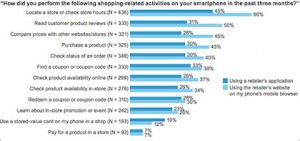By Ajay Kapur
There have been countless debates about the demise of the mobile Web at the hands of mobile applications. Who is winning? No one can agree.
One pundit sees apps dominating users' attention. Another predicts apps will kill off the entire Web. As the saying goes, “Prediction is very difficult, especially about the future.”
The reality is neither solution will go away, and it is a mistake to pit one against the other.
The truth is both serve a useful purpose, and both have limitations in terms of meeting the needs of users in any given context.
Let us consider some key facts.
Biggest brands have it made
Mobile apps represent a small fraction of the total mobile revenue for all but a handful of the biggest brands.
Amazon has more app revenue than mobile Web revenue. Walmart is getting close to parity. Most are not even close. Why?
Benedict Evans summed it up most succinctly: “Do people want to put your icon on their home screen?” The answer for most brands is “no.”
Does this mean retailers should not create native mobile apps? Absolutely not. But the goals are different.
Apps are for retailers’ most loyal customers by definition – who else will download your app?
So instead of a generic shopping app, consider a VIP program for your best customers, delivered through an app. This will not only drive more revenue from these customers, it will also make their experience better.
Nordstrom, for example, targets its most loyal customers via a mobile app that delivers store notifications and promotions based on where those shoppers happen to be.
Nordstrom customers can also see real-time inventory of stores closest to them.
Another example is Dick’s Sporting Goods. The company has focused its efforts on its iPhone app as a digital hub for the company’s Scorecard rewards program. It targets special promotions for its most loyal, active customers.
The apps versus mobile browser discussion is really about audience segmentation and user behavior patterns.
While apps are ideal for nurturing loyalty, the mobile Web is preferred for convenience and reach.
A recent Forrester Research report shows shoppers prefer to buy from mobile sites while on the go.
 Forrester chart on mobile Web versus apps
Forrester chart on mobile Web versus apps
Shoppers show up to a company’s mobile site, not their app.
In fact, across industries, the Web drives 2x the site traffic of apps, according to a recent Morgan Stanley report.
This is driven by the fact that a company’s mobile site is intimately connected with all its marketing activities including email, search engine optimization and marketing, and affiliates. Its mobile app, even with deep linking, is not as richly connected.
This richer interconnectivity gives the Web an advantage not only in attracting new audiences, but it also means that the mobile Web provides better consistency of experiences across channels – and across devices.
Apps are for loyal users and mobile Web is for reach
In the changing face of mobile commerce, the ongoing debate between mobile apps and the mobile Web is about trade-offs.
Apps can be expensive to build and develop. And they are most useful for a niche.
In fact, the stats around apps are sobering.
Consumers currently spend more than 85 percent of their time on their smartphones using native apps, but the majority of their time – 84 percent percent – is spent using five apps.
Those five apps will vary from person to person. For some, their top 5 could include social media or gaming, while others may spend more time in instant messaging.
According to both Nielsen and Forrester Research, communication and social apps account for the most usage, followed by games, music and streaming video.
Aside from the top 5 apps, creating loyal app users is not easy, with 69 percent of users opening an app 10 times or less, and a quarter using the app just once after downloading it, according to Localytics’ analysis.
A consumer may have one or two retailer apps on her phone such as Amazon, though she shops at many more stores. Her choices are tied to frequency and loyalty: she likely will not download 10 different retail apps.
Instead, she will use search and the browser to find information from retailers she is more casually invested in.
BOTTOM LINE: The Web is for audience reach, and mobile apps are driving engagement from loyal customers. If done right, both are strategic and valuable.
So when it comes to mobile, it is not a question of Web versus mobile apps. It is picking the right approach that will yield better results for your customers.
Ajay Kapur is cofounder/CEO of Moovweb, San Francisco. Reach him at [email protected].
{"ct":"x6E+CIKQbNiTRVf6qdGVYdT4vsxRvLz43JcnDmXjwawn4s6RcM+MVkS9bQ3lRFEGRBB8d87gVvocSaMgD7\/sQ0QdcS3hy2EOJdeO767wmYahITWspgc\/yFg3yOnmDM7DevNYeng9YYv+X6XX5ddqjvlDSKpVe3waHjWhNEd2AE5sY+8GUV7FdM4Wqo8B5wHIHAwO3c2zXImZuR7YUxG3EMgMuPa\/Dko7rIDMw6utLye2Yls2e27JTEL8uZZSwUgg5XnqZ\/hqm+\/E+78TBkfgKwkTYeOyH13INRsDzcvq9w\/Q84sv7uuzowOqYjP02DHVx7T56ks09LCVf+6VGbYsj4sLW8B7gSZFPMZ5lSj6ArdUFh7p3KVAvHtjr8Zf9eelp4kHgEMoVrWonkqyjwfxGXCG556TLw6Qoz9exs+V\/nZLBcBqqHMsfMxGTh5ZBbYynnkU\/mKi32RjZy5cAArCWStDswiXDS5+guCOKt4PPuWcus0GRAlNVy+fviqbk3av8jDwVWCV+I8sP9y6fLYFqPMmXtRgJ\/Ih3Ia7pa+eYPgyqmDRdLFnVHri9DfyGeBv5KtBVszF3XCaJKFnc9GQl0iUjTmyzuk6epoFq+scNcjotzCDRfTqzDkuOLc\/EyS1kp1fy5oO4No0H\/WGBY3JA9qEdlL1X8fAA3YKu0bzrZ0tKSN5wWZg3\/kgF2jfwXdrYshGtgwbpt8W9fgwxok9zJ9JvIpCg41UKnxLEY4Spj+OcIczBH6QZ\/Pcw+JU296KVkJKqbKLy0yGXMNr3uAoLk59WGW2LGJ6uoon7pLuCFwqg9Fbxu5dTdN+1hGSIN+HlZ9d0JOf7qffkwHfZ7zc5FplBFpiU99sEAbco5dzx38jFZEd\/KJJenIQZUPK7fHKkp+NanaNon1Cgjj7FtasuOVRPLNAl4kRC\/XBcgngL+z0\/rO+yMb8iVRUVjTsORLMStqrZHu4PoO6r1s36T6PYjev56GgIyuolP9RvffMNRapIEW3NCv8YZBrNPezaTwYRpiQqsWN86MnfQeAdZlSvaj84pilZB+0sGGE2bDDayRR6MtNaJPScKbfIxJQJaLI\/tRjas\/RIFIvPx2g3QdFBPGOCjw0PyPLZgG4tAjSSZqWUILqL0WPCGyLolyelIvc2yZoQGZIqxEg4tX7Zn0BBfdAFe\/g+3lMkuOQ5P455Yo+GYFUTZMvM\/qfYmnTRcwKvphRhDFi3Lp0EFuhD79NzmCf5V0YogzTtjKbgxrp7GmHVcV3WiCeKmkULMfwn9tFYm369uRr2IOevLjpqE+IAGNHwMA79+JeVr9uACtTpQBZXJe3et3x1lMm78\/Axwr3a8YBsSYCLu\/AOXz2ltfhNv5JgmHU8iBZ3QVCVbWykBvJgm\/4pP1F3BB17HsqgjgTqf0okIF+Nd5y0sN1szL4LLELg4kNXD8vpTA6yKzbYEF1UrpEdUVw7pCOFcUV2An2VD8OgtETtzF\/8OeYGSOm1IzGsQx+z5aOurpwv4Lo24ewZAVaNAwvd7DPDnkIQe5OFx3pdFL9eeZeNVqdU89T4zIqn3JAY0gM99EKXjdrcaimmj9AbJqTtEdKghETRMeIUg4Eeht6ZmKibjPG3Zw2ENpWw3wuqQh8Zzf8vjtlnTvPtar0TEeQ6SwBbQsvD1L9bn1gU3R8l3F0NNEKwqxjHlOdA1V\/JhGcJjttc\/Xh23WWG6zGUn2\/LOm8rkWc0uLqoeAFNWri6qJidu0oN66kPjWuelcjV3gA+SVVRZuMekJgNcxgIan0YvRyEOzgKhGKfHpGgu9Ua8lEjK95ZQpEfXgPjDSu7Mps3QpXBNKV\/vo8LI3OhpxYJiAwArqudiUpmo2G5f\/4Dnz7UFHwQtRJEOhgTu0+vq7x1n7KowUDNp57jYNeplwzElvFo0OrUY5UAhYCmae\/fwHiZd8mPScctEzX\/0TlRvDtbO2DzRRVmUuNVyaJWYcwHDKUQNi+JG6J4u2ivyRFvzR2R7w9JHgEY7Hc6Eso+qqdRnlEYYmwYVfIlPIxo+HujwkyKWWe3XALLHAqJOqa7zzNJ5GauCOZRqhBZxI4H3sO0dxAirsIZ9yksocO4DoxL4afK+MvBGZy1IjmMEFw59DvwCx1IQtGWI0uYk40Xmx+cq6F\/LNcN4W01prAr4pt0OqeHdirSMcQSJu1A1z9acYsHxL7eXD16fBG99sxpSOImScVrTissjFX4RSANH0bMBeSKtpXbaYYQij7jq1mnvBMbj5VNEjD1vRxPbAm2eBtHrwsFtLdUDf00OywbyM5piuUQrL\/lqn\/K4QFkvldW8brbZBZtia\/bd3b\/R+2X5ED4vvqOxSluJcauII0doGkFOAiLRcxQBr3yP5K1qS+kGDFexLgbt3HtJ85RhzIwsO+epcnrGBh3QwGxiydQ058VwDpiOY6xZUfl6u+OayKboBOlmlF7RTPJ48rdO6pTO04DrszPnsiaGm09\/vY0cPO2R1cQH7ALC2OSbAGi22URwooC7pm1qclK1o9N\/IPSuNsQs\/snDJhVSidSYBrAZkhSBsyExa+Qly0j9\/EGGhXMEqbWSKCicug4gZEKKtYkxMJkkJNOYS8uo1zSCHPzMweG1urozIkOU9H\/vaTRVlRte3s\/tqJGu3wMzvw2gSxXGVsTs7ESpJn0bNU9ZR8XfOzgnTwCyfkWY4IQK\/us3CEMv8rvAvtDYKfFFv+apmyt12b7que0rF7aMqQ0SaNm265Ci7PzcjW00C9jvNhJKY0\/WXhn79u5z3DJORtrjjVhtOp4KTM8q8lo9j39+YMHFTinINIkqrL8\/kc3ZJBdlebrFMoU4OSk+SwfFeinl2fEfumImsws1JEpnrAx0g0kd4mfx+IkTzOdsS6491m1S69k6YztSrK8M6dyg8PBaAmmVksRygvLSAk3EypP8E3dFQAyIYa9xEfH+\/ysHUsFqM8tiovdDltHDuUeGLmPoBRIzqyylEJyU8YLk\/yuAAi7HjiXiST7cbqRCRUJ3QQpfSgBA2lsnFDGmBc3sRTiivFchRSws\/7GrIrx5b\/brZ8+GcPmieWJoqS5ucBMTiu\/zOxOEsQonOFYKJhFgcud44i9LGE9oFZLulPbc6XYbFDc8izJKLt8iqzI2IljJCunWbLcK3HbmXvgg1YOr9yHIHyHn0nlgFzekY7CzfH70PPFHZAzxYZOnuhNAnJ0hELozMXA2tAQEJnSlf7XMYlwlZHpsQvamwEv7semzH32XfCUjBsxwXWezf+tArBS+H6R9niAm4OnkjuHx5wt2F2m25RhwVA1m6tbLhfyn+WXD55cKdm+rUMZBJ9ErM5zrV6MoFNlYY65AeR51u9Mode\/v43FYWZQMB976KYMLLnf+32a7XzTvT530iPZxo\/dRKhWWtuShXMvKvbNwBoNyKIyUGV\/52+UhSiCwlnqV\/5AYpdKmcNbIL8oj1BSGCzhuJ6XDAm1B0NyZbegojZdpWp3DH3H5N8t2IPiDiW+WSIv41EhjnG9pP1scuNiQs0UAMJQKbXPg4RN2HhDhrwJTMqCFtHMaYXhPxevuf5CZMgWahndmQP3rMKl60pdWs72mx9E0bE+U7VwzzkfR4QX0Sgrm5HBJ\/5yMtXycVHUtsThtUq\/PyRTq0wHLvWfZ+aJB9zclM7m+qeWs\/HIHUmzPyc9vOw2IeOCmua5zozb1eQmsjQyy\/yaRFVkaMbFxoQ6icG6KqyVR80nQPXIZ0j29qOsJwfLXmzwpe5mp0rfWtiq2LB4RXdXmno7eB9GrengNY5rW1NHReD7ZldVqW589kBnV\/iyI69q8M3xS2xDYXsUd0qCs\/IsKdz\/qfiwnkp6m89MVBw\/D\/LJrSsdNgqXyxiCwySYSWx0IwJZGEO+AJGhWoVVtdFKbIVTy5z10pyg8Ip9IQGtmHBDneAGr5NXWwjoqYYwcB1Pol+Dx3wfUo8Cg2MAfeAqAi9Psn0jtojFxvNIdDP5BEFlWaCs6Fvzt5kE8onrjsVHbWo5rSpDSYDA\/aR+DZiTTxzqInYFpdlbbfaAroqGm7ez2ia2gY4RxPqu0UWxSoAeA\/EjTGq5qxYrImzrYaSboSpUGCUI9UpFj1ISsC0OyPRSCEvHpZsF4ZCSyRSyac3nPX6D91dctkVaV+WXFQMXwDCpUUyfGL8ilXuV38QKWDKKo8UTnMlhepO2i3BiJycxrTOxYLH0obLwkdyBlNx\/y41VlW3uumsaORQtEfAoLuPTvlCzicZz0APZTdJRqecqEZrtRpUQDDLZRDqMx70FGOhSfZD1MGFiYJQZ\/nHkylbUfgmCdsRmCrrjHqZ1Vc\/j3vse6K0o9irtx5cDlJLb20FEYb8VFDkUQcYadBy8VpmZ0EsH7YqOEKG1nSo5\/VpgN9H9BqHVPFqiwskm\/jb948V2bqTZ08VS0+JD56DvCC9PdlMZHMfUcBiJzrUukMDt4Sh6LKe2N73gnMAZ37M6+MbNqSP\/LCD41OmI3q4DFiPa98Oh7\/5H4c+Stz2SKwyxfNOIyc+9Fdx6cu1prYHl8uV0umW4xbppUap2xHmd\/7xjjq1eajvgE+Fq8Vo6SmeHL2sjxLGYr1gO3nTJNnexeHbgY\/kjefbLJvOyaFCbdyVvCnn6yQELhLLb\/efxu\/9bGrLR\/t0vA13MIt4i2R27Swqf4UrsgOfOMlGUmQ+N7Ql3YH16Kbqf\/4CRO3q\/U1C4Nkeud43A8YEE2P7L6c1l6B5gnhuEZoATVUKnORzjEzk2wHjuyZ8chpvNiYwlsoCYxQ4kD6YJFN6Z4LFweufncY7zeI5lI+K5D68idj4SBRKX5TxO4L0iyJ\/uS2gMPw1ZKmVcKPSmp5E+X3eOXq3Gd5daN0cBwea74kIjc72jRHjPuCIbh\/EOXAAFMLwg+B6mxmQ9sTENYIM6VZAyaHfcW5ed7LG3ueWQvyix1ASl62Tq8L3yTr0MpH134w3W6V51GSmxWTIOZr75FhsMkfNidaZ8v158yqtwKj8Oz8ZuTFJpwYqfOXYCDEHqur9H5UBUWWH6tYE5+xroWObxuE9qUfV8G03qLjrJd4CdSwmCVMX7PioFx9VrZAyh2X5+bDmonO\/jeMXGcstijok6LYQqv8xMVgexgezMWwr632OP1u4V2r2v0cWo7pM+vbyUKRklf1O0DmTjxxCGuU7RaIAtCZIIt+vQvTbvcrifoV2mnDYB6fea7BQnx\/BWp3wNsLUM1B3CYyE857yMgce5N+0exmcLkXuJsxvgORevTGRxS2T1JKIM\/GrpZPYHXcE5ML47f8kkuEEdPYKIU+CNi3\/1OR7borhWbA4kUvn3bFsGVIlXhfOKyyPTzjNT91fYQ4C9JJWYUJKczpVeioUD1wSWlLtnyQXmw0tiUfvMwbEkQtYkyYVxFkr0Ab2oEHHxmUB8RKHoJbMb2jt6jT8YrCuRaDGkDEDg5rfvDFVLghrbyBKrIdqqUbAiQyXAdlo2SUz+huILp60\/OtRQyQOTy3ADhiYowBcDyjyFuByn6\/EnO2N1wm4AjqG5qxezUQj7\/BjZvxmNdSpqoaUx0IZ+yk8CmPZmC3trTvwXKNZ2UK8YmxZ+Dr+zGkgN1eHADFiZqsLp5j5T2jKshF+217v5lghRNYgOGs1kLJOMCeOjRnmv2poR8pcGEZ\/x1RwrrZEmK\/vFBIvkm+Y978LpbLFFYDiY3JsnOFk1IIew\/Vvkn00RDX34qwahlhnjYZAO0v1jD+cEZ7SypyLjoY2RYHtgN9vn7ogPOuVd23a\/HPHH9XMq93BmwWIuY72S8tIWYSzJ2Orbdg\/IQQEVcopFhME6m9ghkZUOfOg5x3o9qBwD3ZD0Y\/mjQeBcf53iiX\/JzfaRoNektnZYYIgWqjDYSmhoof8I4TejM2LALzDGKzOt49bL5Q81GGP1Ikk9ANE2JlwyrHebSWDoxxULON1ZYFrG5IqHSf3GivA79iiJRu2lfY8f+KbTMC2EPVcsPM4nEQ5R5mxaE3ptRvMmlnc6BYUfxnzBCBHzg8LA4wkfLQ2aouwWiM2EIa00XYR+Uw7bCOh9FK7hlJUm+sR0h5TyhkcKV2Mw1E6s6b0kZ2lCrAlP3iZiYt6ZV\/qW4hj8GSAoEqV73IiMbLCUT8ZReizfmzMPn\/41DgHruGALnDO03Q3R2yVyKJrjGQbNhhsz8Glesfaz4C5Apjn2uxZV0wAlV3RkW1dNl2X4HH299lKVrxhWyRDafhX4GUtye7uEcpToJZRkfiFhLrRki0abV5LSCUqEal0uCu9zOzL7e+XjFe3pPGoHf+FLJ9al3fq24CcDOdBn8le7xD6Ba10XmHFWFy+gAnLKK+dJc17XqQx6tzL064HwkpGD67WdcjPeY2PCZMw6pV4nBXu1z0FfTIEn46+6t2WGHdG2s3W+x6ORaJkF37kQceciIY0c8ukwkMtPJUA51Xi9GcTZvUOpNdbNjlmp1Pxe6mRPyii3pYDFXEUSwse2vv9Dhq0c\/seGwGuNVVWihZtRJJM+HHCjzp3HxbE8gg08QgXDEqSxKPopjsnB5mKQlsrJMQW9BkWUBFdJBZw\/gntce831cb2laOuevTEm4bFi4XXZHPE49oy2NfBPODasofwctHnJdqv+Mj2+I2vN61\/22ghvnY7cg+VrR6Wtl4Y+p6cZcNr3z3Dy4eRhe6NFYxlR+Q3YiXZurRK7XKjLjEj30WI\/gadsbEV7DPq6eDhUOGPQ2XnrY+VJEb23MFyPfxMLiGSgwvvwzr3sLAUAB7Z9scA\/+95PfFlWMPEWRMGTxT5KvrnL+WCIfavBaDN7xrdHThnL92wzgsjg0Mkkak6RphQWbWg86QdBG7Ts5\/\/0jTDzmn0mIfMW\/Lj2uqCiyIb5OhsMW3ndIR5zS3\/UXKcvbSgstHfgB39WH\/wzi7+06+sxS2v\/kPXdqnJSC+2g2PcYw4pO8wBnxsvEKtekj2K+vf27mcxa6WxdC5Rf6Kxm6+7PqkVNl4Ax4h6HcBNSmygKisPjdjqf+PUPqH8dR9OVqNTaz5kxswg4dazLhecPT6ihLClFykgzqKiLq\/6njaXQYWdBIwfB8y1RG9sd0cBQDO7z70oL4JlJBM9r5IenmTPywT9ke3JVHVTNhFwftYPUIEfbLi86hSBofAIw5Zi6lQ4lbMuljcyPg5xgsv5zNZecQWJf46n+meqR\/pOKtWJszuiEFTOOOSC94gvkC0FkKtiWJd7XhAN8FFKqkLlmke6z51zR2IZgUlb2SFVT\/HoL\/5h+NI\/7XGT3ofzFQXMz8IXQT7NIWk\/MRq3DPe0v2sPj989jZqzyxSpgDZvW+pF\/UlYHqi2EqJ0jC9eXSqm7rVWLPSLn0QfQPCOCN78N4JoA0KfklkBFp1\/Gq\/1honWfGwriB\/xcrVTqHn4Pp6ZYePWrLb9YNw9C9CiLTiWB+zol8BdUhNs3ERtI80SkB07s0\/qH4p1m38csLWSULCsI\/IXP3M2XDwDv\/dk8X3p7SHolGH8DOs7y+8IcMQjOlbBwCHi5u87G7ZnUwuZij1IhSLkrKiK\/5ew9AhsiKbjp6GkZY+YtxfKFLfHzieNDupQvOLJDzXXUme8Yk7otqjcJlQ9oP6UKn4=","iv":"60a36b9abee35c5bff92ce511b0a66c8","s":"e51a80b7a1ee4212"}

 Ajay Kapur is cofounder/CEO of Moovweb
Ajay Kapur is cofounder/CEO of Moovweb
 Forrester chart on mobile Web versus apps
Forrester chart on mobile Web versus apps